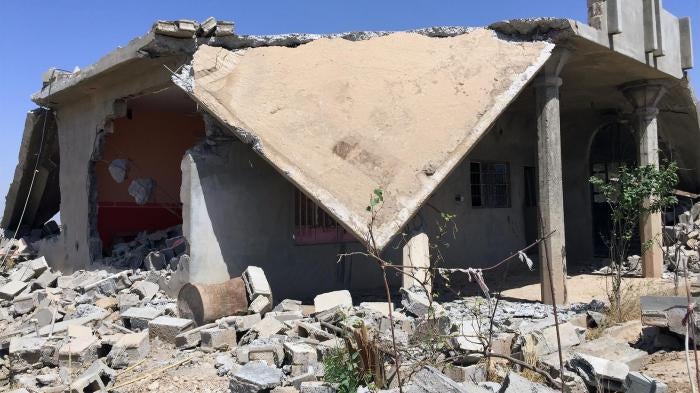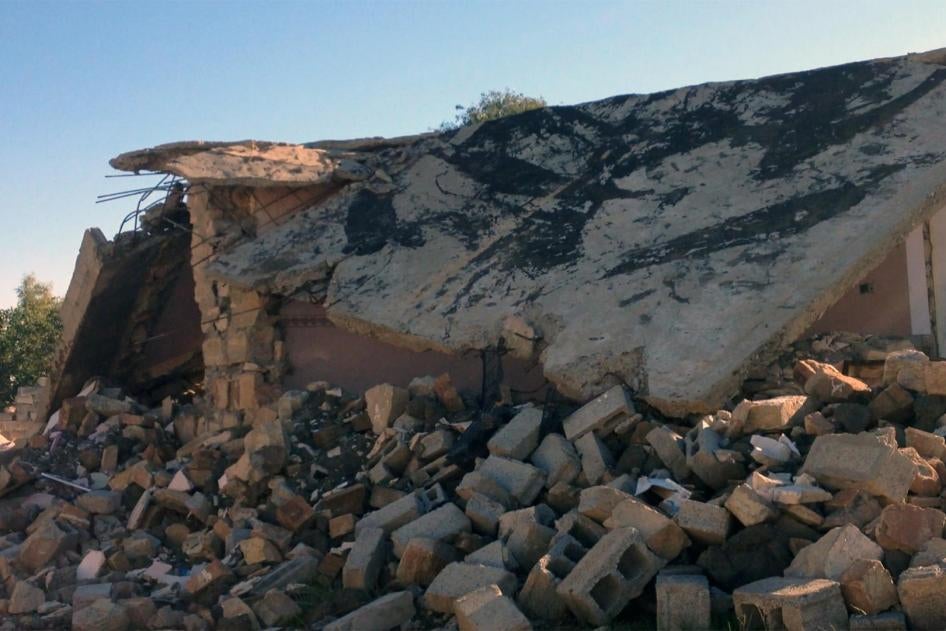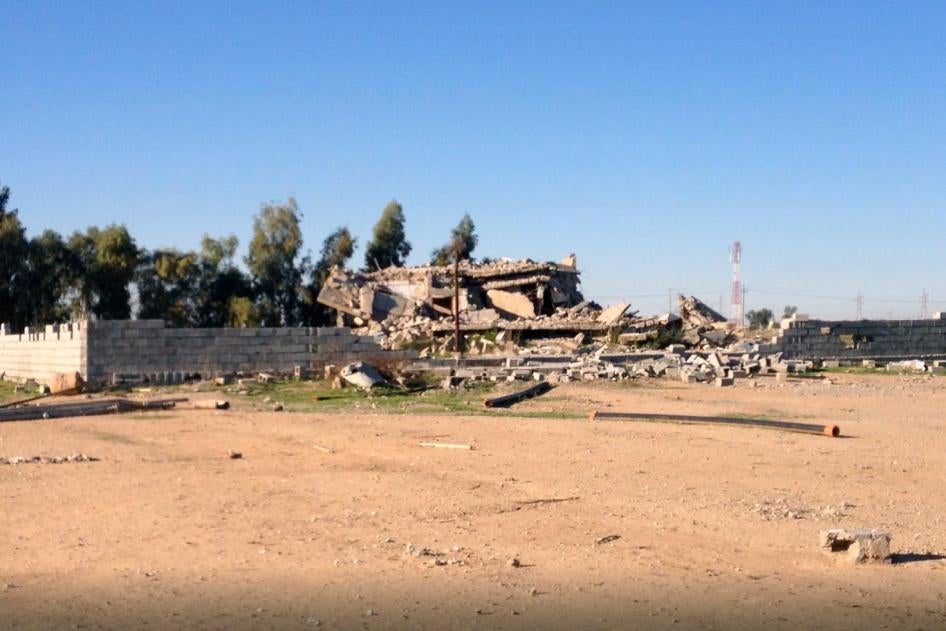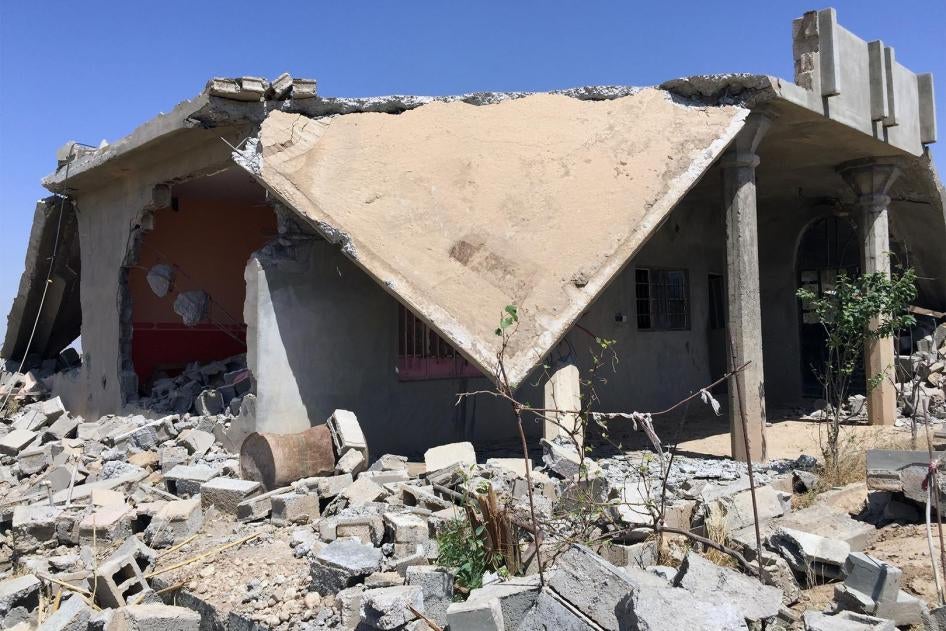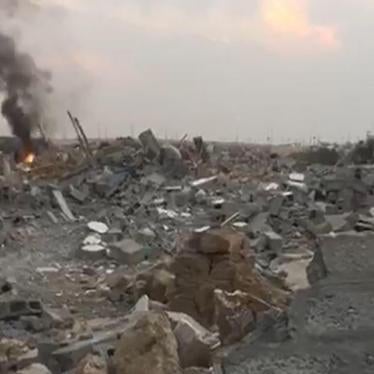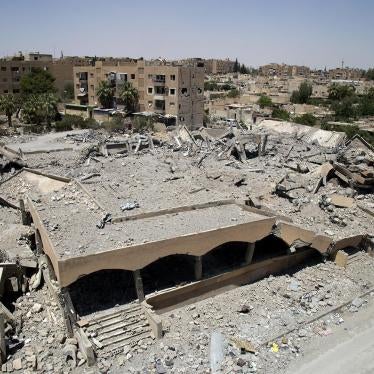(Erbil) – Security forces of Iraq’s Kurdistan Regional Government have unlawfully destroyed large numbers of Arab homes, and sometimes entire villages, in areas retaken from the Islamic State, Human Rights Watch said in a report released today.
The 80-page report, “Marked With An ‘X’: Iraqi Kurdish Forces’ Destruction of Villages, Homes in Conflict with ISIS,” looked at destruction of homes between September 2014 and May 2016 in disputed areas of Kirkuk and Nineveh governorates, areas nominally under Iraqi government jurisdiction but under Kurdistan Regional Government (KRG) control. The destruction, which took place after KRG Peshmerga forces routed Islamic State (also known as ISIS) fighters, targeted Arab homes while leaving Kurdish homes intact. KRG leaders have maintained that these are historically Kurdish areas that they intend to incorporate into the Kurdistan region.
Human Rights Watch documented additional cases of unlawful home demolitions carried out in late October 2016. Details appear at the end of the news release.
“In village after village in Kirkuk and Nineveh, KRG security forces destroyed Arab homes – but not those belonging to Kurds – for no legitimate military purpose,” said Joe Stork, deputy Middle East director at Human Rights Watch. “KRG leaders’ political goals don’t justify demolishing homes illegally.”
At a time when Peshmerga forces are driving ISIS from villages on the outskirts of the major Iraqi city of Mosul, the United States and other members of the US-led coalition should insist that KRG leaders and Peshmerga officers end these unlawful attacks, Human Rights Watch said.
The report is based on field visits by Human Rights Watch researchers, more than 120 interviews with witnesses and officials, and extensive analysis of satellite imagery. Human Rights Watch closely examined home demolitions in 17 villages in Kirkuk governorate and four in Nineveh governorate, and traveled through other destroyed villages in Nineveh, close to the Syrian border.
Of these 21 towns and villages, Human Rights Watch visited 13 that bore signs of significant destruction. In all but three, at least half the buildings were rubble, and seven were empty of residents. For the other 62 villages and towns, satellite imagery shows significant destruction consistent with the use of fire, heavy machinery, and high explosives, distinct in appearance from destruction resulting from air strikes and heavy ground fire prior to ISIS’s retreat from these locations, but a lack of witness accounts does not allow for definitive conclusions about the circumstances of and responsibility for destruction in these locations.
In Nineveh governorate, Human Rights Watch visited Bardiya, a mixed Arab-Kurdish town; Hamad Agha, which has an Arab and a Kurdish part; and Sheikhan, a nearby Arab village. In each place, local Kurdish civilians said, Peshmerga destroyed Arab but not Kurdish homes.
In Kirkuk governorate, several inhabitants of al-Murra told Human Rights Watch that they witnessed Peshmerga destroy the village – including by blowing up the local school – after Peshmerga regained control in a brief battle with ISIS in July 2015. KRG officials said that the al-Murra destruction was because inhabitants were ISIS supporters. But destroying the homes appeared to violate the laws of war prohibition against destroying civilian property except for imperative reasons of military necessity.
KRG and Peshmerga officials told Human Rights Watch that some of the property destruction resulted from bombing by the US-led anti-ISIS coalition and Peshmerga artillery fire. This is consistent with Human Rights Watch analysis of some before-and-after satellite imagery. But in the overwhelming majority of cases, the satellite imagery showed damage patterns consistent with the use of bulldozers, fires, and high explosives – hardly safe ways to clear mines and explosive devices – after fighting had ended and KRG forces were in control.
KRG and Peshmerga officials also said that their forces often needed to destroy homes because ISIS had rigged them with improvised mines and explosive devices. But demining experts said that was inconsistent with accepted practices and that uncontrolled explosions risked dispersing explosives throughout rubble, making the area and later cleanup extremely unsafe.
In many cases, destruction of homes and villages took place weeks and months after Peshmerga retook control, indicating that eliminating ISIS-planted explosive devices was not essential to KRG military operations and did not meet the test under international humanitarian law of imperative necessity as a justification for attacks on civilian objects.
In other instances, Peshmerga demolished buildings in villages that ISIS had never captured. In some of those cases, KRG leaders said their forces had destroyed homes because one or more inhabitants supported ISIS.
In a meeting in July 2016, KRG President Masoud Barzani told Human Rights Watch that the KRG would not allow Sunni Arabs to return to villages that had been “Arabized” under former Iraqi President Saddam Hussein, saying these were, in his view, rightfully Kurdish areas. Such territorial claims lend credence to the belief of many Arabs in the disputed areas that KRG security forces carried out demolitions for the purpose of preventing or dissuading Arabs from returning there. The laws of war prohibit attacks on civilian property except when an enemy is using it for military purposes. They also prohibit indiscriminate attacks, including attacks that treat an entire area, such as a village, as a military objective.
In a more recent round of demolitions and displacements, Kurdish authorities ejected at least 325 Arab residents and Arab internally displaced people from Kirkuk governorate following an ISIS attack on Kirkuk on October 21, 2016, and demolished at least 100 homes. In the days leading up to the expulsions, Human Rights Watch examined satellite images from September 2016 to October 12, 2016, and identified 85 demolished buildings. The images showed most of the destruction took place between September 11 and 27, in the “June First” neighborhood in southern Kirkuk, inhabited by a mix of long-term Arab residents of Kirkuk, families who fled violence in Diyala and Baghdad in 2007, and Arabs displaced from ISIS held territory in 2014.
The KRG should investigate allegations of violations of international law detailed in these reports and hold those responsible to account, Human Rights Watch said. The US, Germany, and other countries providing military assistance to KRG forces should press the regional government to carry out these investigations. The United Nations Human Rights Council should expand the investigation mandate of the Office of the High Commissioner for Human Rights on ISIS abuses to include serious violations by all parties, including KRG security forces.
“The pattern of unlawful KRG destruction of Arab homes and villages is deeply disturbing in its own right,” Stork said. “More than that, it is a recipe for continued conflict even if KRG and allied forces dislodge ISIS from Mosul and other territory it controls in Iraq.”
New Cases of Unlawful Home Destruction and Displacement by Kurdish Forces
Qarah Tappah, Kirkuk Governorate, October 2016
Aid workers told Human Rights Watch that on October 9, 2016, Kurdish forces, including Peshmerga, Asayish, and Kirkuk police, surrounded the Kirkuk governorate Arab village of Qarah Tappah, 14 kilometers west of the city of Kirkuk, and forcefully displaced between 3,000 and 4,000 residents. The security forces summoned residents to the main mosque and ordered them over the loudspeakers to leave their homes. Two hours later, the authorities went door to door, without showing any written eviction order, and gave residents two to three hours to gather their belongings. They then bused the residents to Daquq camp for internally displaced people, about 30 kilometers south of Kirkuk. As far as Human Rights Watch has been able to determine, the authorities gave none of the families any reason for the evictions or any compensation.
At the time of the displacements, the village was about 30 kilometers from the nearest front line and there had been no explosions or other reported security incidents there that would have indicated that the village was unsafe for residents who wished to remain. There are no known key military structures in the village. Human Rights Watch attempted to visit Qarah Tappah but was refused entry by Peshmerga at the village entrance. The village appeared to be deserted except for several patrolling Peshmerga. Researchers could observe near the village entrance some of the homes whose destruction is documented in the report (pages 23-27). The local Peshmerga commander, when asked, said that there had been no further destruction of homes since those documented in May 2016. One displaced resident later told Human Rights Watch that Peshmerga torched a number of homes, including his own and his brother’s, but declined to say how he knew this.
Qutan, Kirkuk Governorate, October 2016
Human Rights Watch visited Qutan, a mainly Arab village 18 kilometers northwest of Kirkuk, on November 8, and found that virtually the entire village had been destroyed or heavily damaged – according to villagers, approximately 90 out of 100 homes. Only the homes of 10 or so Turkmen and Turkmen-Kurdish families remained intact.
Several residents who had come back to retrieve some belongings said that in the early morning hours of October 21, the day of a large-scale ISIS attack on Kirkuk, a dozen or so ISIS fighters entered the village around 4 a.m. and took over the mosque, raised the ISIS flag, and used the loudspeaker to harangue the residents to support ISIS. Several residents said they notified the nearby Peshmerga post. Peshmerga forces arrived around 9 a.m., the ISIS fighters fled, and “it was quiet by 10 a.m.,” as one resident put it. A resident of a nearby village told Human Rights Watch that he had heard gunfire from Qutan at the time. A resident from Qutan told Human Rights Watch that two Peshmerga and one villager were wounded in the attack. He also said that the ISIS fighters commandeered the car of a villager, filled it with explosives, and blew the car up at a Peshmerga checkpoint on the highway not far from the village, causing additional Peshmerga casualties.
Four Qutan residents said the Peshmerga then took about 70 village men to a Peshmerga base across the highway, and told the remaining Arab families to leave and to go stay with relatives. After two days, they transferred the men to an Asayish base. Asayish officers released them all over the course of the third day.
Abdullah Taleb Abdullah, a 37-year-old lawyer, said he was not forced to leave right away because he spoke Kurdish, although his two homes were among those demolished. He said that the Peshmerga brought in front-loader tractors (he referred to them as “shovels”) the same day and began hacking at homes.
A 50-year old oil company employee told Human Rights Watch that he had left the village the previous day:
On Friday, a friend called and told me Peshmerga were looting the village. I called a security officer I knew in Kirkuk and asked him to take me to the village. He agreed, and we arrived around 3:30 p.m. The Peshmerga didn’t let me to go inside [the village]. I stayed on the main street trying to convince them to allow me in when I saw a white pickup pulling my Toyota Corolla. A guy wearing a Peshmerga uniform was in my car. When I told him it was my car he said, “And now it is mine.” A Kurdish neighbor convinced him to give my car back. The next morning, I asked some Kurdish friends from Kirkuk to help me to get my other car. When we came to the village, I took out my car. I saw people wearing Kurdish clothes looting our houses, and I could not say anything to them. I saw the houses close to the main street were destroyed.
Abdullah Taleb Abdullah said that over the next two days, Kurdish forces – this time Asayish, he said – brought in two bulldozers and proceeded to seriously damage and demolish homes. When he asked why they were destroying homes, he said the response was, “Why didn’t you fight ISIS.” All of the residents said the ISIS attack early on the morning of October 21 was the first Qutan had experienced, although there had been ISIS activity in areas nearby, and that there were some known sympathizers in the village.
Qoshkaya, Kirkuk Governorate, October 2016
A displaced resident from the Arab village of Qoshkaya, a dozen or so kilometers north of Qutan, told Human Rights Watch that over the course of several days beginning on October 24, Peshmerga forces forced them to leave their homes. Human Rights Watch had visited Qoshkaya in May to document the destruction of about 30 homes a year earlier, as documented in the report (page 36). When researchers visited again on November 8, they found many more homes bulldozed or torched, as well as the primary school and medical clinic.
The village was entirely deserted of residents, but researchers observed perhaps half a dozen small groups of Kurdish-speaking men with pickups and medium-sized trucks – in one case two men in Peshmerga uniforms – looting belongings such as refrigerators, washing machines, windows, and door frames.
Researchers spoke with a man and woman in a much smaller Kurdish village of the same name just across the highway. When asked why the Arab village was empty and houses destroyed, the man replied, “They were Arabs, they were ISIS, relatives if not directly.” Both Qoshkaya and Qutan, the woman said, were home to “known troublemakers.” Before ISIS emerged in 2014, they were Al-Qaeda and Baathists, she said.

